| An Introduction To Tourism |
|
ECONOMIC IMPACTS
Positive and negative economic impacts
Other than tourism, cities nowadays have few options for economic development (Fainstein & Gladstone, 1999, as cited in Ioannides, 2003).
Tourism is seen as an attractive sector for policy makers mainly due to its wealth and job creating potential. ‘Ordinary residents have also often benefited from tourism-related investments, both financially and through improved amenities’ (Fainstein & Gladstone, 1999:24–25, as cited in Ioannides, 2003).
Table 2 shows the positive and negative economic impacts of tourism. These will be displayed by positive and negative impacts. This was derived from reviewing credible literature.
Table 2: Positive and negative tourism economic impacts
Tourism is seen as an attractive sector for policy makers mainly due to its wealth and job creating potential. ‘Ordinary residents have also often benefited from tourism-related investments, both financially and through improved amenities’ (Fainstein & Gladstone, 1999:24–25, as cited in Ioannides, 2003).
Table 2 shows the positive and negative economic impacts of tourism. These will be displayed by positive and negative impacts. This was derived from reviewing credible literature.
Table 2: Positive and negative tourism economic impacts
Sources: Hall (2007); Ioannides (2003).
Key points:
- tourism can generate jobs, improve infrastructure and diversify a community's economic base
- tourism can potentially create 'bad' jobs, lead to leakages and result in increased crime rates.
Key points:
- tourism can generate jobs, improve infrastructure and diversify a community's economic base
- tourism can potentially create 'bad' jobs, lead to leakages and result in increased crime rates.
Different types of economic impacts
Primary
- direct: direct consequence of tourist expenditure (Eg. food purchased by a tourist)
Secondary
- indirect: respending through local business transactions (Eg. restaurant staff member buys beef for the restaurant)
- induced: additional income for personal, non-tourism related use (Eg. restaurant staff member buys beef for their own barbecue)
- free from geographic boundaries, it doesn't matter how or where the money is spent.
- direct: direct consequence of tourist expenditure (Eg. food purchased by a tourist)
Secondary
- indirect: respending through local business transactions (Eg. restaurant staff member buys beef for the restaurant)
- induced: additional income for personal, non-tourism related use (Eg. restaurant staff member buys beef for their own barbecue)
- free from geographic boundaries, it doesn't matter how or where the money is spent.
Nature of tourism multipliers
A multiplier is the 'coefficient which expresses the amount of income generated in an area by an additional unit of tourism spending.' (Archer, 1982). It measures the change in income due to an injection of expenditure into an economy through, in this case, tourist spending (Archer, 1977, as cited in Lui & Var, 1983).
It is an indicator of the prosperity brought about as a result of tourist spending in a specific region, as it stimulates economic activity, increasing business activity, household disposable incomes and jobs (Lui & Var, 1983). Therefore they are used by council to gauge the worth of one tourist to a region.
However, it is only considered a multiplier if it stays within the geographic region (supply chain), otherwise it is deemed a leakage (eg. imports). The size of the tourist multiplier is a reflection of the circulation of the tourist dollar through the economic system in a geographic region, thus the larger the tourist multiplier, the more self-sufficient the tourist economy (Hall, 2007).
It is an indicator of the prosperity brought about as a result of tourist spending in a specific region, as it stimulates economic activity, increasing business activity, household disposable incomes and jobs (Lui & Var, 1983). Therefore they are used by council to gauge the worth of one tourist to a region.
However, it is only considered a multiplier if it stays within the geographic region (supply chain), otherwise it is deemed a leakage (eg. imports). The size of the tourist multiplier is a reflection of the circulation of the tourist dollar through the economic system in a geographic region, thus the larger the tourist multiplier, the more self-sufficient the tourist economy (Hall, 2007).

